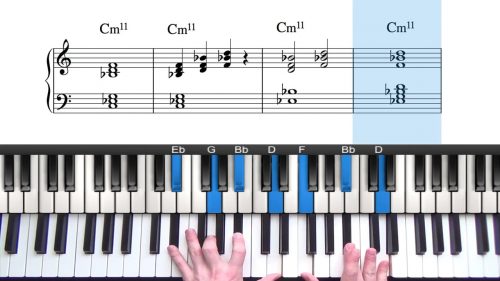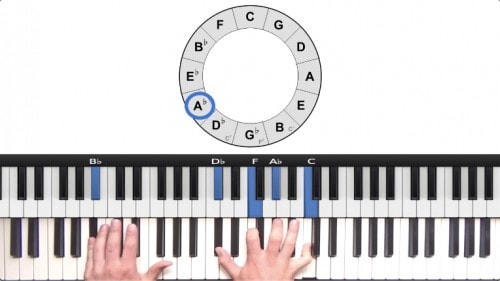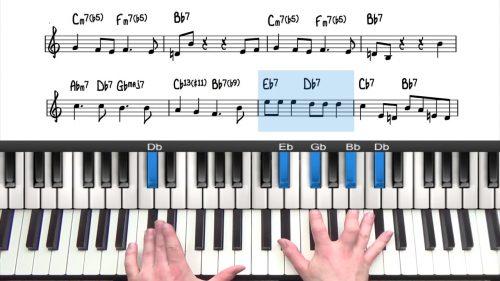13b9 Chord Progression Drill
In this lesson we expand upon the previous exercises by introducing the b9 chord alteration into the whole step 251 drill. We start in the same position as the last drills and explore a useful formula for accessing the b9 tension in all 12 keys.
What Are Chord Alterations?
Chord alterations include the b9, #9, #11, and #5/b13 and these tensions can be used to add specific ‘flavours’ and ‘colours’ to our dominant chord voicings.
If you are new to altered harmony, also check out the related lessons referenced on this page for a more in-depth explanation on chord alterations and how they are used in jazz piano.
The Formula For Dominant 13b9 Colour
Lowering the 2 middle voices in our right hand is the formula that we must remember to access the 13b9 chord colour when playing a Type A extended 251 progression.
Once we have completed this exercise, we will become familiar with the ‘movement’ or ‘hand gesture’ which is used to access this chord colour in all 12 keys.
Lesson Downloads
-
Whole Step 251s – 13b9 Chord Colour File Type: pdf
Practice Tips
-
The b9 is likely the first chord alteration that you will introduce into your playing.
-
The beauty of this exercise is in its simplicity; simply drop the 2 middle voices in any Type A extended 251 progression to access the 13b9 colour on the dominant V7 chord.
-
If you are new to altered harmony it's useful to play this exercise slowly to visualise and internalise the location of the b9 in relation to the other chord tones.
- Once this exercise has been mastered we can introduce the other altered tensions (#9, #11, and #5/b13) into the whole step 251 drill.






Hi! Thanks for the precious material. I have a question…do you think it is worth practicing the same 13b9 chord progression drill with type B voicing? Thanks!
Hi Marino,
I’m glad you enjoyed the lesson.
Yes we can practice all of these drills in Type A and Type B.
For this particular drill it is nice to start with a type B ii-7 chord, and then play a V13b9 chord as an upper structure triad. For example these are the voicings for a 251 in C major:
D-9 (root in left hand and type B right hand 7-9-3-5) G13b9 (root and b7 in left hand, and E triad in right hand in second inversion) Cmaj9 (root in left hand and type B right hand 7-9-3-5)
There are endless variations on these drills and the idea is for these lessons to give you the initial inspiration to explore other variations – so well done on being curious about the type B variation here.
I will be adding more drills to this course in the near future.
Cheers, Hayden